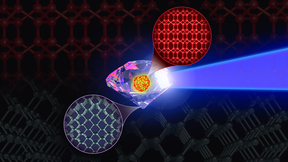From RAGS to riches
 (Download Image)
Members of the RAGS team with the apparatus. From left to right: Bill Cassata and Carol Velsko, primary RAGS operators and data analysts; Wolfgan Stoeffl, RAGS designer; and Dawn Shaughnessy, principal investigator for the project. Photo by Julie Russell/LLNL
(Download Image)
Members of the RAGS team with the apparatus. From left to right: Bill Cassata and Carol Velsko, primary RAGS operators and data analysts; Wolfgan Stoeffl, RAGS designer; and Dawn Shaughnessy, principal investigator for the project. Photo by Julie Russell/LLNL
The Radiochemical Analysis of Gaseous Samples (RAGS) is a true trash to treasure story, turning debris from the National Ignition Facility's (NIF) target chamber into valuable data that helps to shape future experiments.
The RAGS diagnostic, developed for NIF by Sandia National Laboratories and commissioned in 2012, is a cryogenic system designed to collect the gaseous debris from the NIF target chamber after a laser shot, then concentrate, purify and analyze the debris for radioactive gas products. Radiation detectors on the apparatus produce rapid, real-time measurements of the radioactivity content of the gas. Based on the results of the counting, the total number of radioactive atoms that were produced via nuclear reactions during a NIF shot can be determined.
If the number of target atoms in the fuel capsule and/or hohlraum (cylinder surrounding the fuel capsule) was known prior to the shot, then the results from RAGS determine the number of reactions that occurred, which in turn is used to determine the flux of particles that was produced by the capsule as it underwent fusion. This information is used to validate models of NIF capsule performance under certain shot conditions.
If specific materials are added to the capsule or hohlraum prior to the shot, then reactions related to a particular experiment can be measured. For instance, there have been gas-based experiments designed to measure areal density (a measure of the combined thickness and density of the imploding frozen fuel shell) and mix (a potentially undesirable condition during which spikes of the plastic rocket shell penetrate to the core of the hot fuel and cool it, decreasing the probability of igniting a sustained fusion reaction with energy gain).
"Radiochemical diagnostics probe reactions that occur within the capsule or hohlraum material. By adding materials into the capsule ablator and subsequently measuring the resulting products, we can explore certain capsule parameters such as fuel-ablator mix," said radiochemist and RAGS principal investigator Dawn Shaughnessy. "There are plans to add isotopes of xenon gas into capsules specifically for this purpose - to quantify the amount of mix that occurs during a NIF implosion."
RAGS can be used to perform basic nuclear science experiments. Recently, the diagnostic has been employed during shots where the hohlraum contained small amounts of depleted uranium. Gaseous fission fragments were collected by RAGS, including very short-lived species with half-lives on order of a few seconds. Based on these observations, there are plans to use RAGS in the future to measure independent fission product yields of gaseous species, which is difficult to do at traditional neutron sources.
"This opens up the possibility of also using RAGS for fundamental science experiments, such as measuring reaction rates of species relevant to nuclear astrophysics, and measuring independent fission yields," Shaughnessy said.
In addition to Shaughnessy as PI, other contributors to RAGS include: Tony Golod and Jay Rouse, who wrote the NIF control software that collects data and operates the diagnostic; Wolfgang Stoeffl, who designed the RAGS apparatus, and Allen Riddle, who built it; Don Jedlovec, who serves as the responsible system engineer; and Carol Velsko and Bill Cassata, who are the primary RAGS operators and data analysts.
Contact
 Breanna Bishop
Breanna Bishop
[email protected]
(925) 423-9802
Related Links
A New Detector for Analyzing NIF ExperimentsNIF
Tags
National Ignition Facility and Photon ScienceNational Ignition Facility
Lasers and Optical S&T
Lasers
Science
Featured Articles







